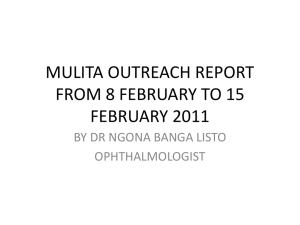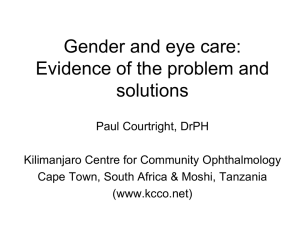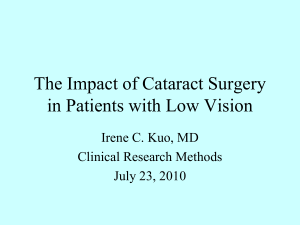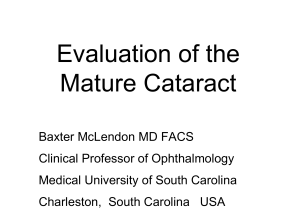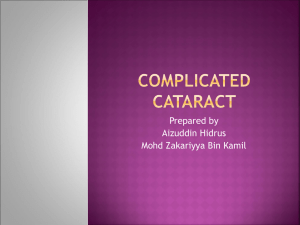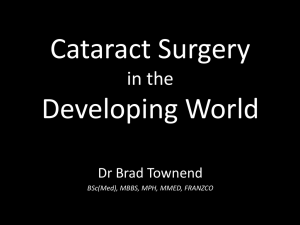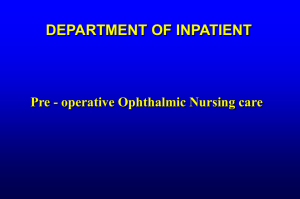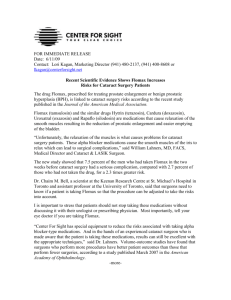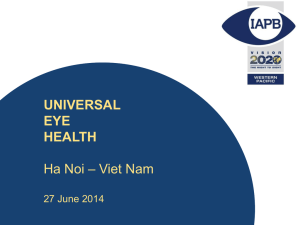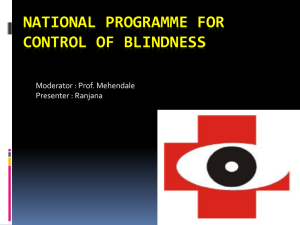“funnel” strategy: screening, diagnostics
advertisement
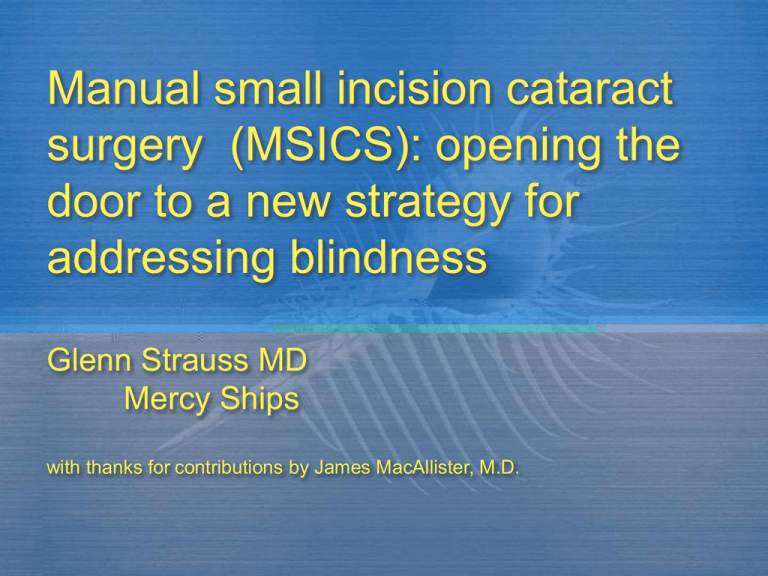
Manual small incision cataract surgery (MSICS): opening the door to a new strategy for addressing blindness Glenn Strauss MD Mercy Ships with thanks for contributions by James MacAllister, M.D. First high quality alternative to phaco An elegant sutureless ECCE procedure It is ideal for situations where high quality, high volume output is desirable without high-tech instrumentation or equipment Provides an alternative to standard ECCE when phaco is high risk. Opens the door to new strategies in patient care Ideally utilized as part of a team system to maximize efficiency as a single procedure approach to cataract surgery Increasingly being utilized as an alternative tool for high risk cataracts Integral part of a “funnel” strategy: screening, diagnostics, perioperative care, and surgical care Has provided a new paradigm to address the problem of global cataract blindness The funnel strategy Utilizes key skills at each level of care Maximizes use of individual strengths Surgical yield in areas of low access is approximately 15% of those being screened Criteria based: Decreased vision, nl pupils, clear cornea If surgical goal is 3,000 cases, 20,000 will need to be screened, 8,000 examined. MSICS features: Flexible enough to be used with a variety of cataract pathologies Quick, efficient surgery once mastered Rapid recovery Minimal postoperative corneal edema • Minimal induced astigmatism (studies show comparable to phaco) No sutures to be removed late Low cost per case A brief review of the technique as practiced on Mercy Ships Anesthesia Routine peribulbar or anterior conal blocktopical possible but less desirable Lidocaine 2% 5cc alone usually sufficient because of short case time Orbital compression helpful but does not require soft eye like ECCE Routine prep and drape Topical 5% betadine conj. drops and skin scrub, isolate lashes Adequate conjunctival/tenons dissection and wet field cautery May use flame cautery if only option but avoid over cauterization Dry carefully before scleral dissection Scleral incision With fine toothed forceps hold limbal tissue and create 7.5 mm “frown’’ incision 1.5 mm from limbus at apex of the frown. 1/2 to 2/3 depth. Initially it may be easier to make a simple linear incision Sclero-corneal tunnel dissection Carefully follow the curve of the globe, slicing anteriorly approx 2 mm into clear cornea centrally Take care to “straighten” the limbal junction angle A 3 to 3.5 mm tunnel length (half the length of the crescent blade) Premature entry results in iris prolapse Tunnel button hole is easily fixed with new tunnel plane Sweep to each side to create an 8 to 8.5 mm internal opening Tunnel size can be titrated to the anticipated size of the nucleus Paracentesis at 9 o’clock with 15 deg blade- no anterior chamber maintainer necessary Useful for reforming chamber Keratome entry at anterior most extent of scleral tunnel Sweep keratome left and right “floating” in the tunnel to fully open. If done well, chamber is maintained. Consider supporting AC with viscoelastic Careful 8 to 8.5mm “can opener” capsulotomy after filling AC with viscoelastic. CCC may be done for softer nucleus. A C B D With capsulotomy needle inserted into nucleus, “rock and roll”, rotating and lifting the nucleus from the capsular bag A B C D With lens loop, depress posterior lip of scleral tunnel and allow nucleus to glide out through the incision. (must be large enough) Tunnel acts hydro dynamically like a funnel Nuclear material never contacts endothelium Facilitates increased efficiency of nucleus removal Improves safety in high risk cases (trauma, zonular instability, partially dislocated cataracts, hypermature cataracts, previous surgery) Gently depress post. lip of tunnel to milk out remaining lens material while tilting the globe by holding the limbus at 6 o’clock Remove remaining cortex using suck and wash approach (dragging cortex to center of pupil and releasing). Standard Simcoe is not ideal instrumentdesigned for limbal incision. Chamber maintenance is dependant on making inner opening the pivot point. The eye is now ready for lens implantation. Fill anterior chamber with methylcellulose or air. Insert IOL and remove methylcellulose. Inject BSS to moderate pressure. AC should remain formed. No conj closure needed. Complete the operation with routine antibiotics +/- steroid. Remove the speculum by lifting out inferior blade first Other techniques for MSICS ACM Fish hook Plastic glide for nucleus Phaco nightmare Results 250 200 150 100 P re O p V is ion 50 P os t O p V is ion /3 0 /8 0 20 -2 0 /1 6 20 -2 0 0/ 10 0 0 -2 0/ 20 HM CF PL 0 Results Number of P atients C hang e in vis ion 100 90 80 70 60 50 40 30 20 10 0 < -2 0+ /- 3-6 7-11 122 16 17- 22- 27+ 21 27 C hang e in vis ion / L og MAR lines Pre and post op visual function 180 No of patients 160 140 120 100 80 60 40 20 0 Post-op Pre-op Average number of lines improved Improvement of vision by age: 30 to 40 y/o success are primarily traumatic cataracts. 25.0 20.0 15.0 10.0 5.0 0.0 0-30 30-40 50 60 Age of patient 70 80+ overall * p<0.05 Reported success rates from developing countries 120 % of patients 100 80 60 >20/80 40 20 0 20/200-20/80 <2/200 Barriers to implementation Cost: low cost does not mean NO cost Local regulatory issues Lack of clear, positive motivations for the team and surgeon Medical community resistance: MSICS is gaining credibility Ophthalmic corporate resistance: less dependence on high tech equipment Surgeon skills For discussion: how to take advantage of this approach for the benefit of South Africa Brief review of recent RAAB study Eastern Cape Rapid Assessment of Avoidable Blindness in Eastern Cape Province of South Africa S.Saravanan of PRASHASA Consultants On behalf of FHFSA Summary The all-age prevalence of blindness for Eastern Cape Province of South Africa is estimated to be 0.58%; The all-age magnitude of blindness for EC Province is estimated to be 38,354 people out of a population of 6.57 million; Avoidable causes of blindness accounted for 73.2% of blindness, 86.1% of severe visual impairment and 85.7% of visual impairment. Summary Cataract (62.2%) and sequel related to cataract extraction (1.2%) accounted for 63.4% of all causes of bilateral blindness; Posterior segment disease is responsible for 31% of bilateral blindness; 36.1% of people with bilateral cataract VA<3/60 had surgery and 18.9% at VA<6/18. Results – Cataract Surgery Coverage Cataract surgical coverage: 36.1 % of people with bilateral cataract blind (VA<3/60) had surgery and 18.9 % at VA<6/18; Results – Cataract Surgery Outcome 22 % of the 109 eyes that had undergone cataract surgery had a poor outcome (i.e VA<6/60) with best correction; Best corrected, good visual outcome (>6/18) was estimated as 64.2%; 109 eyes had cataract surgery with 79% having an IOL implant. Results – Cataract Surgery 99% of all surgeries performed were at public health facilities; 19.3% were using spectacles after cataract surgery. KEY FINDINGS - Productivity Demand and Supply mismatch. Number of surgeries not enough to match “incidence”. Low surgical Productivity CSR in Eastern Cape province = 1022 Required CSR = 4,000 “Unaware of treatment”(63.7%, SVI57.8%)

